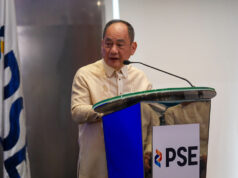Gov’t debt yields flat without leads
YIELDS on government securities (GS) once again ended flat last week from week-ago levels as investors wait for fresh leads that would spur demand for the debt papers.
Debt yields, which move opposite to prices, went up by 2.3 basis points (bps) on average week-on-week, based on the PHP Bloomberg Valuation (BVAL) Service Reference Rates of Nov. 15 published on the Philippine Dealing System’s website.
With the exception of the one-year and two-year debt papers, all tenors saw their yields go up at the secondary market last Friday.
At the short end, the 91- and 182-day Treasury bills (T-bills) went up by 1.7 bps and 0.3 basis point to yield 3.179% and 3.303%, respectively.
At the belly of the curve, the rates on the three-, four-, five-, and seven-year Treasury bonds (T-bonds) increased by 0.6 basis point (4.003%), 1.6 bps (4.141%), 2.3 bps (4.276%), and 3.7 bps (4.503%), respectively.
Meanwhile, at the long end, the 10-, 20-, and 25-year T-bonds saw their yields go up by 3.2 bps (4.706%), 7.1 bps (5.165%), and 7.8 bps (5.186%).
On the other hand, the rate of the one- and two-year debt papers went down by 2.2 bps (3.556%) and 0.7 basis point (3.870%), respectively.
“Yield movements were driven by [last] week’s auction and the anticipated ‘prudent’ or ‘appropriate’ pause by the BSP (Bangko Sentral ng Pilipinas) of its monetary policy tweaking,” said Union Bank of the Philippines (UnionBank) Chief Economist Ruben Carlo O. Asuncion in an e-mail.
For Security Bank Corp. Chief Economist Robert Dan J. Roces, bond movements last week “mostly came from mixed catalysts.”
“For context, yields dropped away from lows following a series of pre-announced RRR (reserve requirement ratio) cuts before reversing gains,” he said in a separate e-mail.
The Bureau of the Treasury raised P20 billion as planned from its T-bond offer last Tuesday as the 10-year securities attracted total bids of P29.3 billion. The 10-year debt papers fetched an average of 4.617%, higher by 42.1 bps versus the 4.196% fetched during the auction last Aug. 13.
Meanwhile, BSP Governor Benjamin E. Diokno said in separate television interviews this month that the central bank is “likely done” cutting rates for the year. This was affirmed in its monetary policy meeting last Thursday where benchmark rates for overnight reverse repurchase, overnight deposit, and lending were maintained at four percent, 3.5% and 4.5%, respectively, describing current settings as “appropriate” amid weak global economic prospects on the one hand, as well as the “firm private domestic spending and sustained progress in policy reforms” that would serve as buffer against “external headwinds.”
After raising benchmark rates by a total of 175 bps last year in the face of successive multi-year-high inflation rates, the BSP has cut these rates by a cumulative 75 bps so far this year. Moreover, the BSP has also cut the RRR by a total of 400 bps in 2019, bringing the reserve requirements for big banks and thrift banks to 14% and four percent by December, respectively, while rural banks’ RRR went down to three percent earlier this month.
“Until the end of the year…, we think further downside to yields will remain subdued as it looks like the BSP has already carried out all planned easing measures, while US yields continue to rise following risk-on sentiment,” Security Bank’s Mr. Roces said when asked for his outlook.
For UnionBank’s Mr. Asuncion: “The market will be expecting a lot from the global front as negotiations between the US and China toward the ‘Phase 1’ part of their potential trade deal continue.”
He added that there would be “no significant drivers from the domestic events” for this week. — Jobo E. Hernandez



